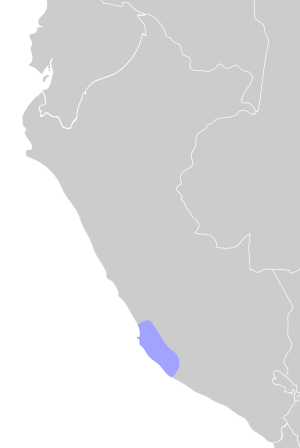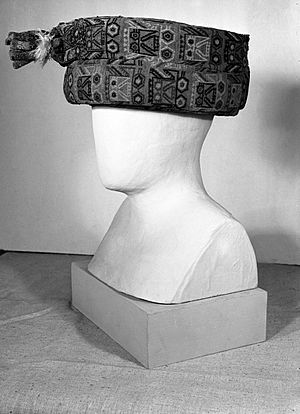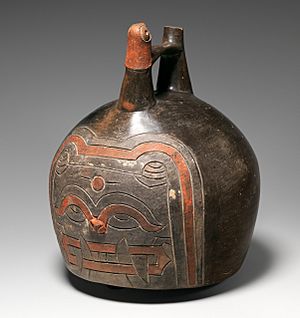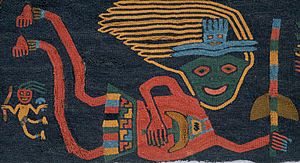Paracas culture facts for kids

Area of development and influence of the Paracas culture.
|
|
| Period | Early Horizon |
|---|---|
| Dates | c. 800 BCE – 100 BCE |
| Major sites | Paracas Candelabra |
| Followed by | Nazca culture |
The Paracas culture was an ancient society that lived in the Andes mountains region. They existed from about 800 BCE to 100 BCE. They were very skilled at managing water and creating amazing textiles, which are special woven fabrics. Their home was in what is now the Ica Region of Peru. We know a lot about the Paracas people from a big ancient site on the Paracas Peninsula. An archaeologist named Julio Tello first studied this site in the 1920s.
The Paracas people had two main ways of burying their dead:
- The Paracas Cavernas were underground tombs dug into the top of a hill called Cerro Colorado. Each tomb held many burials. These tombs were used again and again over many years. Sometimes, the heads of the dead were removed for special rituals, then buried again later. Pottery found here had colorful designs and unique patterns. The textiles were also very complex, showing advanced weaving and knotting skills.
- The Wari Kayan necropolis was a large burial ground with hundreds of graves. These graves were close together, inside and around old buildings on Cerro Colorado. The pottery found here was very fine and plain, some with red and white colors. Each burial was a body wrapped tightly in textiles, shaped like a cone. Most bodies were sitting up, facing north towards the Paracas bay. They were buried with gifts like pottery, food, baskets, and weapons. The bodies were tied to stay seated, then wrapped in many layers of beautiful, detailed textiles. These Paracas Necropolis textiles are thought to be some of the best ever made by ancient Andean societies. They are how we best know the Paracas culture today. Burials at Wari Kayan continued until about 250 CE. Many of the burial textiles are similar to those of the early Nazca culture, which came after the Paracas.
Contents
Paracas Mummy Bundles
The dry weather on Peru's southern coast helps keep old things preserved when they are buried. Mummified human remains were found in tombs on the Paracas peninsula. They were wrapped in many layers of cloth, called "mummy bundles." These bodies were found at the Great Paracas Necropolis along the southern Pacific coast of the Andes.
Discovering the Mummy Bundles
At the Necropolis, there were two large groups of crowded pit tombs. About 420 bodies were found, dating from around 300–200 BCE. Each mummified body was wrapped in many textiles. These textiles took many hours to make because the plain wraps were very large. The clothing was also finely woven and embroidered with great skill.
The larger mummy bundles had many layers of bright colored clothes and fancy headdresses. Both men and women wore jewelry made of gold sheets and shell beads. Some people even had tattoos. The shape of these mummy bundles looked like a seed or a human head.
Symbolism and Craftsmanship
According to a researcher named Anne Paul, this seed shape might have been a choice by the Paracas people. A seed can be a symbol of new life or rebirth. Paul also thinks that the detailed and high-quality textiles show they were used for important ceremonies.
The Paracas people used both native Andean cotton and hair from camelids. These animals include wild vicuñas and domestic llamas or alpacas. These materials came in many natural colors. Yarns were also dyed in a wide range of bright colors. These were used together in weaving and other techniques. Using different materials shows that the Paracas people traded with other communities. They traded with people living in lower and higher places in the mountains.
Art and Meaning in Textiles
The pictures found on these textiles showed ceremonial practices. Some showed a figure that looked like it was falling or flying. Some figures seemed to have face paint. These textiles not only showed important symbols of the Paracas beliefs, but they also helped show who a person was. They could show a person's gender, social standing, power, and what community they belonged to.

Colors and Dyes
Different color patterns are seen in textiles from Paracas Cavernas, early Paracas Necropolis, and later Nazca styles. The dyes came from many parts of the Andes mountains. This shows how people from different altitudes traded goods with each other.
For example, the color red came from a tiny bug called the cochineal. This bug lives on prickly pear cacti. The cochineal was ground up to make a red color. Yellow dyes could be made from the qolle tree and quico flowers. Orange dyes came from a type of moss called beard lichen. For green, the most common plant was cg'illca, mixed with a mineral called collpa. Blue colors were made from a plant called tara. The more collpa mineral added, the deeper the blue color became. Making these dyes could take several hours. Then, it could take two more hours for women to boil and dye the fibers. After that, the fibers were spun into yarn and woven.
Weaving and Embroidery Styles
Paracas woven textiles were usually made on backstrap looms and were often a single color. These fabrics were then richly decorated with embroidery in two main styles:
- Linear style: This older style used running stitches that followed the lines of the weaving. Red, green, gold, and blue colors were used to outline animal figures. These figures seemed to emerge from the background with their mouths open. The stitching created the empty spaces around them. These embroideries are very abstract and can be hard to understand.
- Block-color style: This later style used stem stitches to outline and fill in curved figures. It used a wide variety of bright colors. The figures, which often mixed human and animal features, were shown with great detail and varied colors.
Protecting Ancient Treasures
The beautiful textiles and jewelry in the tombs attracted people who wanted to steal them. After the Paracas Necropolis was discovered, it was heavily looted between 1931 and 1933. This happened especially in the Wari Kayan area. We don't know how much was stolen. However, Paracas textiles started appearing in museums and collections around the world in the years that followed. It is believed that most Paracas textiles outside of Peru were smuggled out illegally.
Because there were not many laws to protect ancient items and stop smuggling, thefts continued to increase. This was especially true for artifacts from South America. In 1970, UNESCO created a special agreement. It is called the Convention on the Means of Prohibiting and Preventing the Illicit Import, Export and Transfer of Ownership of Cultural Property. This agreement helps countries work together to stop the illegal trade of cultural treasures.
Paracas and Topará Cultures
The Paracas culture developed in this region from about 1200 BCE to 100 BCE. Around 150 BCE, another culture called the Topará is thought to have arrived from the north. The two cultures lived side-by-side for one or more generations. They lived both on the Paracas Peninsula and in the nearby Ica Valley. Their interactions were very important in the development of the Nazca culture and its pottery and textile traditions. Even though the detailed textiles have only been found in the dry coastal desert, there is growing evidence that these cultures also lived and traveled in other areas. This included the Pacific lowlands, the Andean highland valleys, and mountain pastures to the east.
Paracas and Nazca Culture
Many experts, like Helaine Silverman, believe that the Nazca culture and its art grew out of the Paracas culture.
However, Hendrik Van Gijseghem points out that there are not many Paracas remains in the Río Grande de Nazca area. This area later became the main home of the Nazca culture. He notes that there are many Paracas remains in the Ica, Pisco, and Chincha valleys, as well as the Bahía de la Independencia. He believes that the first Paracas people settled in the southern Nasca region. Their population grew, and this marked the beginning of the Nazca society.
Paracas Geoglyphs
In 2018, archaeologists used drones to study ancient evidence in Palpa province. They discovered many geoglyphs, which are large designs made on the ground. These geoglyphs are believed to belong to the Paracas culture. Many of them are much older than the famous Nazca Lines, by about a thousand years.
Also, some of these Paracas geoglyphs are different in what they show and where they are located. For example, some are built on hillsides instead of the flat desert floor. More research is being done on these amazing geoglyphs.
Images for kids
See also
 In Spanish: Cultura paracas para niños
In Spanish: Cultura paracas para niños




